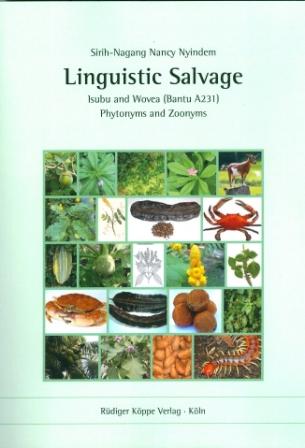
Linguistic Salvage – Isubu and Wovea (Bantu A231)
Phytonyms and Zoonyms. Including a Grammatical Sketch. With a foreword by Evelyn Fogwe Chibaka
Author: Sirih-Nagang Nancy Nyindem. With a preface by: Evelyn Fogwe Chibaka. Series edited by: Wilhelm J.G. Möhlig †, Bernd Heine.
Series: GA Grammatical Analyses of African Languages Volume 60
2020247 pp.
2 colour maps, 346 colour photos, 7 colour diagrams, 41 colour drawings, 9 b/w drawings, numerous tables and graphs, index
Text language(s): English
Format: 160 x 240 mm
530 g
Paperback
€ 69.80
Buy 'Linguistic Salvage – Isubu and Wovea (Bantu A231)' as a downloadable PDF document directly from our online shop »
Order 'Linguistic Salvage – Isubu and Wovea (Bantu A231)' as print edition »
This work documents the linguistic and folk knowledge of plants and animals in Isubu and Wovea, two endangered Bantu languages of Zone A231 (Guthrie) of Cameroon. The terms Isubu, Su, Isuzu refer to the language spoken by the Bimbia people while Wovea, Wuvia, Bubia/Bobea refer to both the language and the people. We observe some free variation between the sounds [b, z] in front of the vowel /u/ for the former and [o, u & e, i] in front of the [o & u] for the latter. In this book, we will maintain the names Isubu and Wovea to refer to both languages and Bimbia and Wovea for the speakers respectively. For purposes of consistency, the names Isubu and Wovea in this book refer to the Bimbia and Wovea/Bubia language and people, respectively. These names are also both acknowledged and used by the administration and neighbouring villages.
The location and linguistic classification introduce the two peoples, their history and socio-economic life, before the informing theoretical basis of the study and some reviewed literature opens up to the study proper: the grammar of the languages in chapter one, the noun classes and structure in chapter two, while the data of their onomastics of phytonyms and zoonyms, respectively, constitute the fourth and fifth chapters, given with both description and linguistic analysis. In the concluding chapter, the focus of the work is recapitulated along with its value, underscored by recommendations to various stakeholders. From this flow, it is expected that contribution to saving valuables from the endangered languages would have been effected.
GEOGRAPHICAL SITUATION
Among the earliest Cameroonian peoples to come into contact with Europeans (over two hundred years ago) were the Bimbia and Wovea villages. Both are among Cameroon’s Sawa ethnic groups, found in Limbe and Tiko subdivisions in Fako Division in the South West Region of Cameroon. Their early exposure to Western visitors enabled them to become influential traders and middlemen. Isubu occupies the coast directly east of the Wovea, their main settlements being Bimbia and Wovea, respectively. The town of Limbe comprises a mixture of Isubu and other ethnic groups that speak such languages as Duala and Mokpe (languages of the Douala and Bakweri people, respectively, see the link below).
LINGUISTIC CLASSIFICATION
Isubu and Wovea fall under the Niger-Kordofanian phylum which is one of the four major language phyla in Africa. They are coastal Bantu languages belonging to the Benue-Congo family of the Niger-Kordofanian phylum. According to Lewis, Simons and Fennig (2016), these languages are Narrow Bantu languages of the Duala group (A231) spoken in the South West Region, Fako Division, Tiko Subdivision, with Isubu situated at the Bimbia estuary area east of Limbe and west of Douala. They are all Sawa Bantu languages alongside Mokpe and Womboko. Alternate names for Isubu are Bimbia, Isubu, Isuwu, Su and Subu and for Wovea are Bobe, Bobea/Bubia, Bota, and Ewota.
Under these links you will find further publications on African phytonyms and zoonyms / onomastics, as well as on bee-keeping in Africa:
Accompanying material:
- A Linguistic Study of Ewe Animal Names among the Ewe of Ghana
(ISBN 978-3-89645-474-4 ) - Expérience végétale bolia (C.35b, République Démocratique du Congo)
(ISBN 978-3-89645-037-1 ) - Honey Hunting and Beekeeping in Adamaoua (Cameroon)
(ISBN 978-3-89645-851-3 ) - Swahili Plants
(ISBN 978-3-927620-89-6 ) - The Akie Language of Tanzania
(ISBN 978-3-89645-714-1 ) - The Mukogodo Maasai
(ISBN 978-3-927620-86-5 )
Cross-reference:
- La dynamique des noms de personnes chez les Ding de la République démocratique du Congo (1885–1960)
(ISBN 978-3-89645-896-4 ) - Language Change under Multilingual Conditions
(ISBN 978-3-89645-724-0 ) - Mòkpè (Bakweri) – English Dictionary
(ISBN 978-3-927620-33-9 ) - Sprachhistorische Rekonstruktionen zu den Ursprüngen von Getreidenutzung und Gartenbau in Nordostafrika
(ISBN 978-3-89645-097-5 )
| « back | Print version | [top] |
 Books
Books Audio
Audio Biographies
Biographies Series
Series Festschrifts
Festschrifts Journals
Journals